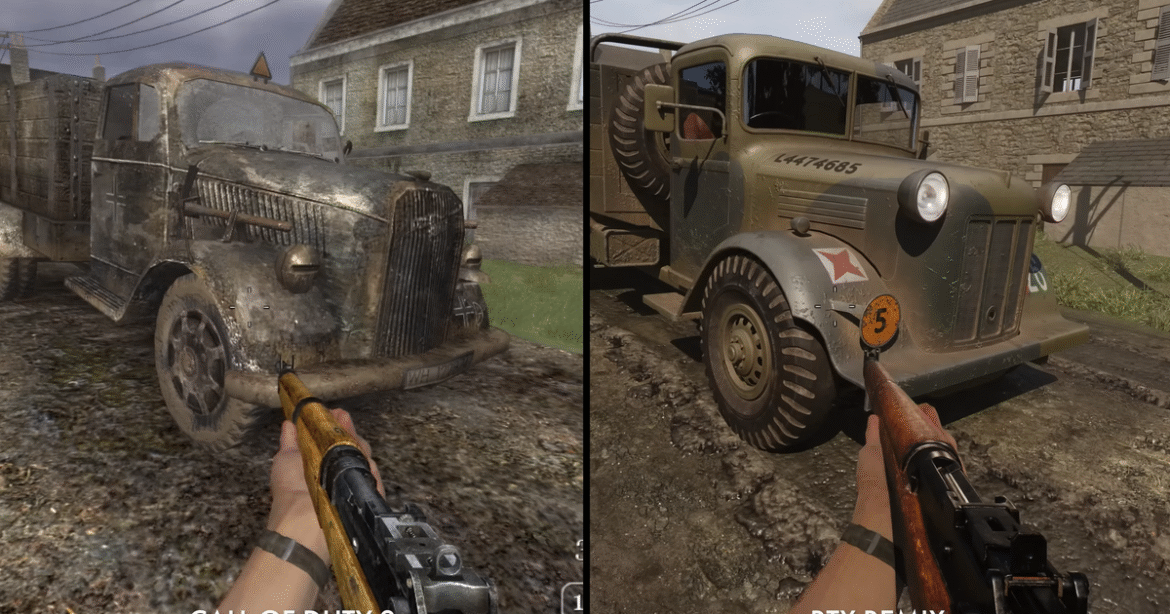As well as boosting its GeForce Now cloud streaming with PS5 Pro-beating hardware and new peripheral options, Nvidia has also detailed some of its recent RTX Remix successes at Gamescom 2025. If you’re not familiar, RTX Remix is a set of tools for remastering old games with modern graphics techniques, converting ancient engines to support ray-traced lighting, shadow and reflections, new particular effects, higher-quality materials and so on. Specifically, the firm is announcing the winners of its RTX Remix contest, and showing off exactly what makes each fan-made graphics mod worthy of recognition. I took a look at some of the winning entries at Nvidia’s booth here in Cologne, and was particularly impressed by the RTX Remix of a seminal classic, Call of Duty 2.
The project is the work of a single developer, tadpole3159, who has been painstakingly photo-scanning real-world WW2 weaponry in order to produce a version of the game that holds up against modern competitors. Like other RTX Remix projects, the aim is to use physically-correct materials, tagging different assets in the game with what they’re made of so that they have realistic roughness, reflectivity and so on. With that in place, objects in the world can react realistically to changing lighting conditions, cast appropriate shadows and produce rough or clear reflections as appropriate.
Digital Foundry looked at the Call of Duty 2 RTX Remix project a little while back. Watch on YouTube
Descriptions of the mod state that tadpole3159 is a lead artist at a UK game studio, which perhaps explains how a single person has been able to create assets (at least for the Carentan level of the game) unassisted. The demo that I saw included hotkeys for changing the time of day, allowing you to see how the game world can change drastically from bright sunlight, to the dead of night, to varying levels of overhead cloud. (The developer is British, the Nvidia reps explained, so they found it easier to produce lots of convincingly realistic grey skies.) As well as the material upgrades, rooms are being upgraded with period-appropriate contents, walls get new details and foliage is expanded to lush excess. It dramatically changes the look of the game, and is an impressive effort for a project made in around two months.
The other RTX Remix projects highlighted by Nvidia are also worth perusing, as they’re all free downloads from the mod.db site. The ones I saw were Vampire: The Masquerade – Bloodlines, which uses more of a “use AI to upscale everything, then hand-make the really important stuff” approach, which manages to convincingly recreate the atmospheric feel of the game while ensuring the entire thing looks at least OK. Painkiller, by contrast, went for a more selective approach, with the developer creating full 3D replacements for what were previously flat textures or static objects, allowing for swinging torches that splash light around the room as they are shot into motion, and intricate ceiling supports that cast complex shadows to produce real depth. That approach requires a lot of research and insight into the original intents of the developers, but produces sterling results.
Manage cookie settings
Nvidia is also continuing to upgrade the capabilities of the RTX Remix suite, with a particle editor that arrives next month. The demo I saw was quite straightforward, showing a half-finished fire effect that was tweaked and tuned by adjusting sliders for particle size, number and gravity. The Nvidia rep explained that most games in the DX8 and DX9 era lacked proper particle editors, so modders normally have to create their own or work around the limitations, but the new tool should make creating particle effects like smoke, sparks, steam or fire much quicker.
If you’ve not played around with RTX Remix before, I’d recommend checking out some of the contest entries and seeing what you think of them – especially if you’re a fan of games in that 2002-2012 era. The full list of winners are as follows:
Image credit: Nvidia
Nvidia also announced that its newish Nvidia app would soon include an overlay for showing what DLSS and other overrides are active – making it much easier to go “did that actually work?” when upgrading to a newer preset – and RTX Hair is coming soon to Indiana Jones: The Great Circle, bringing fancier and more efficiently rendered follicles.
Have you played any RTX Remix projects? What’s your dream game to remake? Let us know in the comments below.

